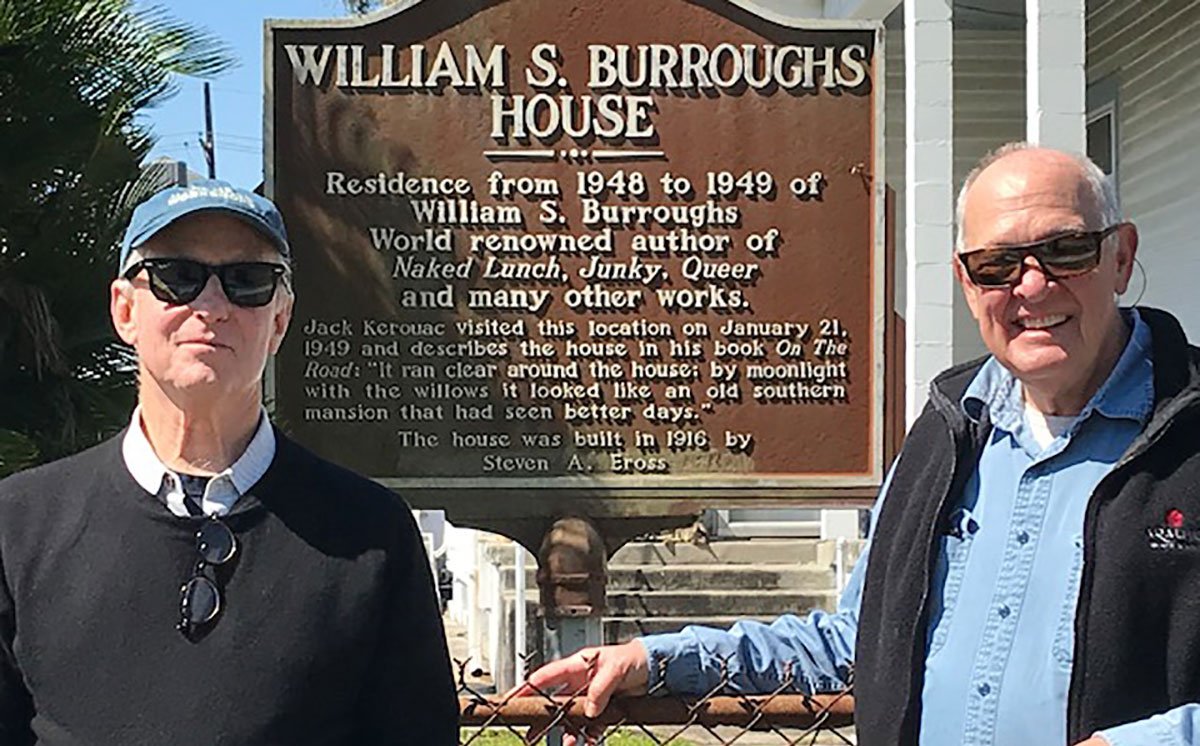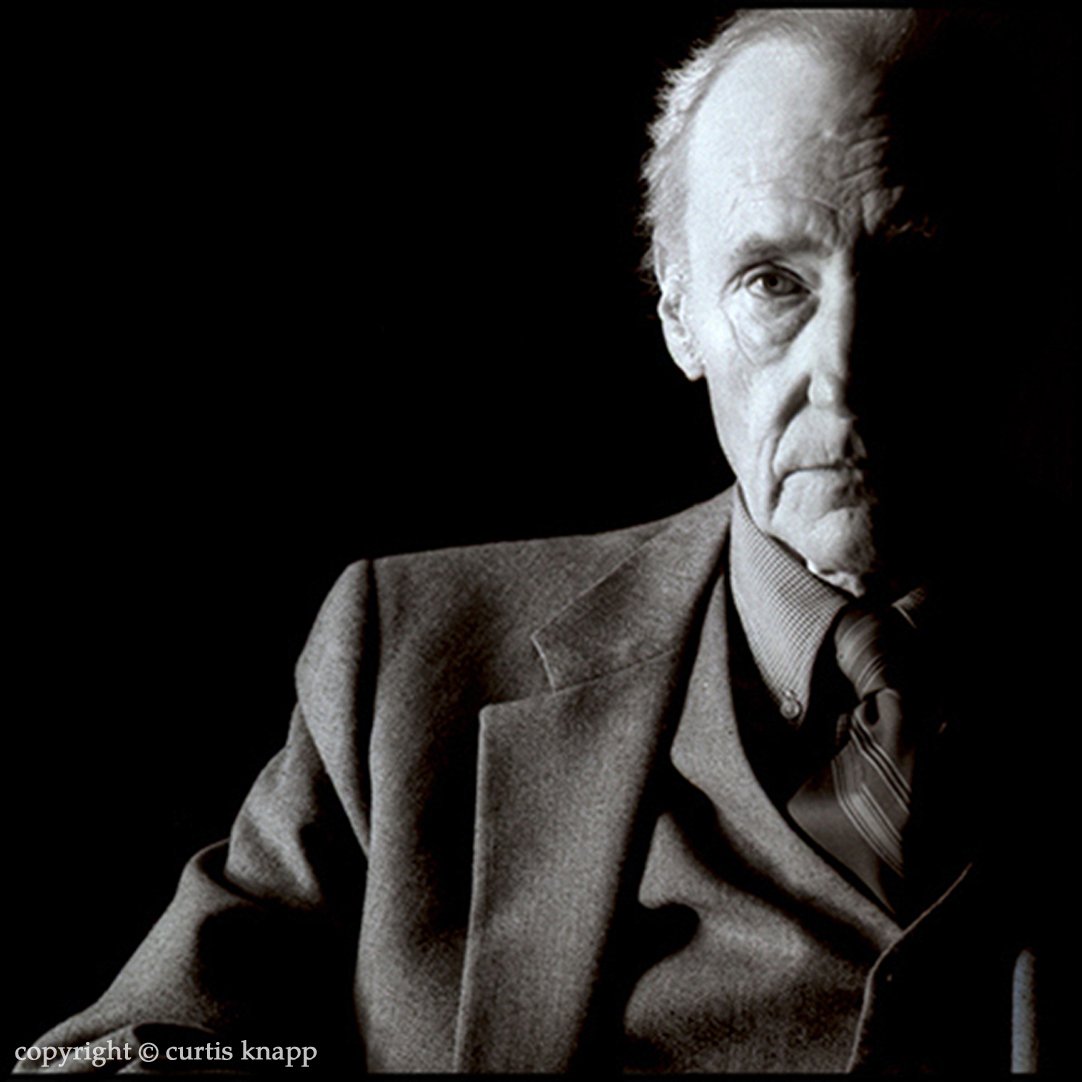A Pilgrimage to Algiers: the New Orleans Home of William S. Burroughs
Writer Richard Goodman and friend Alex Jones at the Burrough’s house in Algiers Point, 2015, courtesy Richard Goodman
June 2024A writer reflects on a London visit with Williams S. Burroughs and a later pilgrimage to the Beat writer’s home in Algiers Point, a place immortalized in Jack Kerouac’s “On the Road.”
– by Richard Goodman
On a late January day in 2015 in New Orleans, my friend Alex and I boarded the ferry to Algiers to find the house where a celebrated writer once lived. The ride was short and pleasant. The sun was out. The temperature was in the low 60s. The ferry nudged into the terminal, and we disembarked. It was a good day for walking. The house, on Wagner Street, was about a mile from the terminal.
We walked past sweet-looking houses on Algiers Point, then followed the road that hugs the Mississippi and, some thirty minutes later, turned inward. We walked a few blocks more, and there it was.
It was a small shotgun with thin columns, in need of care, with a chain link fence enclosing it. The neighborhood was undistinguished, with few trees. There was a standing plaque that told the world who had once resided there.
It read, “Residence from 1948 to 1949 of William S. Burroughs. World-renowned author of Naked Lunch, Junky, Queer and many other works.”
Photo by Kim Ranjbar
As we had walked toward the house, Alex and I talked about a day over forty years earlier, in the fall of 1972, when we’d both come to 8 Duke Street in London, not far from Hyde Park, to visit William Burroughs. I remember how nervous I was as I pushed the buzzer next to the name, “Burroughs.” Suddenly, I heard his voice, a low growl, for the first time, through the intercom,
“Yesssssss.”
My own voice raising an octave to a near-squeak, I replied, “It’s Richard Goodman! From America!”
There was a long pause. I looked at my friend Alex wildly. Then the voice said, “Come on up.”
We ascended the stairs to the third floor, and I knocked on the door. It opened, and there he was, William S. Burroughs, author of Naked Lunch, Junky and many other books, so-called father of the Beat Movement, mentor to Jack Kerouac and Allen Ginsberg, infamous drug addict, cult figure and a unique presence in American literature. He was smaller than I expected and wore a black turtleneck and slacks.
“Come in,” he said, waving a slow, low hand toward the inside. He turned, and we followed him into the apartment.
William Burroughs by Curtis Knapp, with permission. See more of portraits by Curtis here.
Now, so many years later, on that January day in 2015, we were traveling back and forth through time. We were standing before a house where Burroughs lived for a year, in 1948-49. That was sixty-five years ago. We were remembering a London visit forty-three years ago. Burroughs had died in 1997 at the age of 83. This was 2015. It was slightly disorienting.
The house we were looking at is described by Jack Kerouac, who, with Neal Cassidy, visited Burroughs there on their legendary cross-country journey that would later be included in Kerouac’s classic book, On the Road, published in 1957. Kerouac and Cassidy took the same ferry we did from New Orleans to Algiers Point. In the novel, Kerouac calls Burroughs “Old Bull Lee.” (William Lee was a pseudonym Burroughs used on some of his earlier works, including Junky.) Kerouac writes,
“We went to Old Bull Lee’s house outside town near the river levee. It was on a road that ran across a swampy field. The house was a dilapidated old heap with sagging porches running around and weeping willows in the yard; the grass was a yard high, old fences leaned, old barns collapsed. There was no one in sight. We pulled right into the yard and saw washtubs on the back porch.”
The Burroughs they visited hadn’t written Naked Lunch yet, or anything else, really. But he was a charismatic figure. Kerouac and Ginsberg met him in New York City a few years earlier, and he became a mentor to them. This is how Kerouac describes his allure in On the Road,
“It would take all night to tell about Old Bull Lee; let’s just say now, he was a teacher, and it may be said that he had every right to teach because he spent all his time learning; and the things he learned were what he considered to be and called “the facts of life,” which he learned not only out of necessity but because he wanted to. He dragged his long, thin body around the entire United States and most of Europe and North Africa in his time….He was an exterminator in Chicago, a bartender in New York, a summons-server in Newark. In Paris he sat at cafe tables, watching the sullen French faces go by. In Athens he looked up from his ouzo at what he called the ugliest people in the world. In Istanbul he threaded his way through crowds of opium addicts and rug-sellers, looking for the facts. In English hotels he read Spengler and the Marquis de Sade…. Now the final study was the drug habit. He was now in New Orleans, slipping along the streets with shady characters and haunting connection bars.
“He spent all his time talking and teaching others. Jane[his wife] sat at his feet; so did I; so did Dean [Neal Cassidy]; and so had Carlo Marx [Allen Ginsberg]. We’d all learned from him. He was a gray, nondescript-looking fellow you wouldn’t notice on the street, unless you looked closer and saw his mad, bony skull with its strange youthfulness – a Kansas minister with exotic, phenomenal fires and mysteries. He had studied medicine in Vienna; had studied anthropology, read everything; and now he was settling to his life’s work, which was the study of things themselves in the streets of life and the night.”
Drawing of Burroughs by Origafoundation, Creative Commons
The household at 509 Wagner was chaotic. Burroughs, heavily addicted, lived with his wife, Joan Vollmer, also addicted, who he would later kill in Mexico. There were also two young children, one his, and the other hers from a previous relationship. The kids ran wild. There was little food in the house. Burroughs, Kerouac and Cassidy took several trips to New Orleans to scour the bars and, for Burroughs, to look for a fix.
Reading about the visit a sense of squalor runs throughout, yet Kerouac still writes about Burroughs worshipfully. It’s all surreal, flowing with the energy of youth and travel and the strong, odd, unrelenting personalities who were there in the week or so the visit lasted.
Kerouac and crew departed after about a week, and, not long after, Burroughs went to Mexico, one step ahead of the police. One drunken night, he shot and killed his wife in what has been described as a William Tell-like stunt. He fled Mexico to avoid jail. He eventually landed in Morocco where Kerouac and Ginsberg visited him and helped him prepare the manuscript of Naked Lunch.
How did I find myself in 1972 walking in the door of Burroughs’ London flat, a young man of twenty-seven, an aspiring writer, who like Burroughs in 1948 in Algiers, had written very little and published nothing to speak of?
I first read Naked Lunch in 1968 when I was a graduate student at Wayne State University in Detroit. I fell under its spell. I can still hear myself, laughing hard at passages in the book in my cheap student apartment on West Willis in Detroit. I was a convert. I immediately enlisted in the corps of Burroughs admirers and acolytes. After reading Naked Lunch and its predecessor, Junky, I decided I wanted to write my master’s thesis on Burroughs’ work.
When I told my advisor, he was stunned and horrified.
“You mean the William Burroughs who wrote Naked Lunch?!? The drug addict?”
Yes, that’s the one. And yes, I do.
Credit to him, my advisor. He reluctantly said yes.
In the process of writing and researching my thesis, I decided, on a whim, to write Burroughs a letter in care of his publisher. I asked him a few simple questions about his work. I had no idea where he was or what he was doing. Three months later, to my astonishment, I received a reply. Burroughs was living in London.
“Dear Mr. Goodman,” his letter, dated April 1, 1969, began, “thank you for your letter and interest in my work. I have just returned from Morocco, or I would have replied sooner.” He answered a few of my questions. It was a short letter, but at the close he wrote, “Please let me hear from you again.” So began an irregular correspondence between us that lasted about five years.
After I’d finished my thesis—and sent a copy to Burroughs—sometime in 1971, I decided to go to Europe with my friend Alex. I wrote William Burroughs telling him I would be coming to London and asked if I could stop by for a visit.
He said yes.
That’s how I found myself in front of his apartment door in London that fall day. I still find that hard to believe. I wrote a piece about that visit, which lasted far into the evening, a few years later. It was my first published piece, and it was because of William Burroughs. I saw Burroughs a few times after that, in New York, where he moved to from London. We lost touch, but I still have his letters and the memories of our visits, and I cherish both.
That January day in 2015, so many years later, we didn’t stay long at Burroughs’ old house in Algiers.
The thing about pilgrimages like this one is that the person who lived there is long gone, and you are really encountering ghosts. Nobody’s home, so to speak—even literally, sometimes. You walk through, or gaze at, a phantom house. The emptiness can be deafening. So it was in Algiers, that warm day. Burroughs had been dead for over twenty years. He hadn’t lived in Algiers in seventy years.
But I was a pilgrim. I didn’t go to Algiers expecting to actually find Burroughs. I was there to pay homage. I was a devotee. If you want to see and visit with the occupants, they are alive and well in the pages of On the Road, and they always will be.
People go on religious pilgrimages to worship at the shrines of saints and martyrs. I don’t see much difference in what I did that day. They go to make a physical journey, often following in the footsteps of a saint or hero—or in my case, a writer—to their home or final resting place.
It’s a way of acknowledging your gratitude for their gifts to you. They have inspired, delighted, astonished, uplifted and comforted you. You want to publicly acknowledge that. You’re saying, “You once lived here, perhaps in obscurity, perhaps struggling, perhaps lonely and in doubt, perhaps even badly. I am here to give thanks to you and to pay homage.”
That’s what I did that mild January day in 2015 at 509 Wagner Street. I was a pilgrim.
A reading of On The Road including the visit to “Bull Lee.”
Your donations make stories like this one possible:







